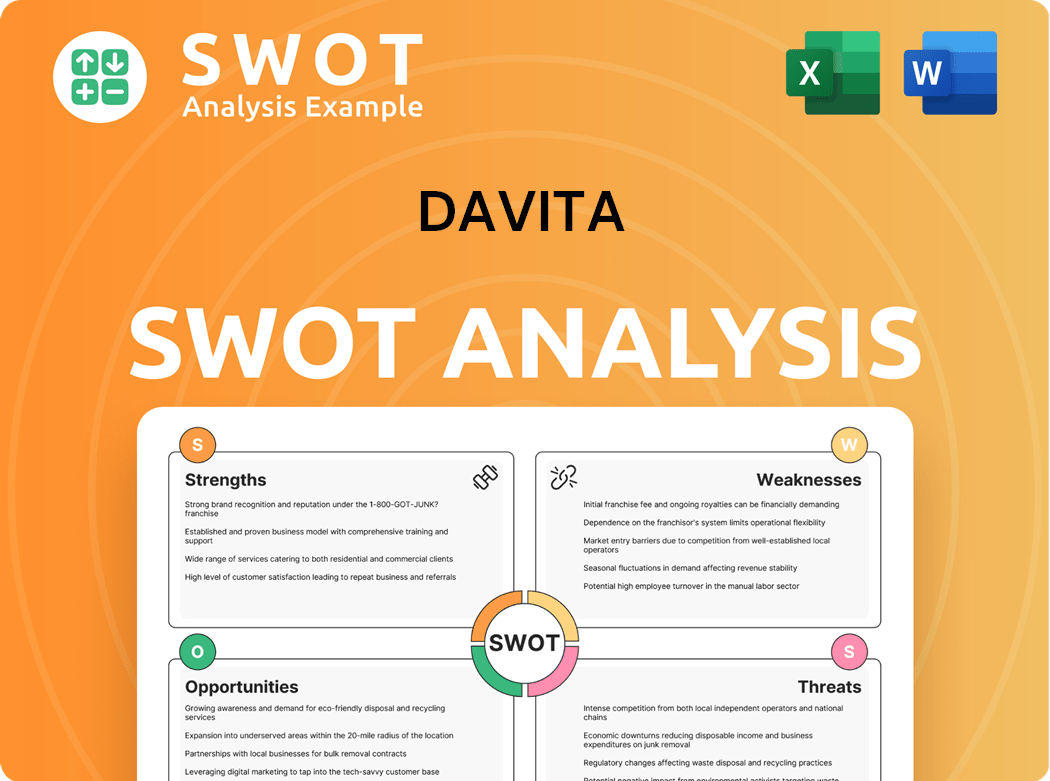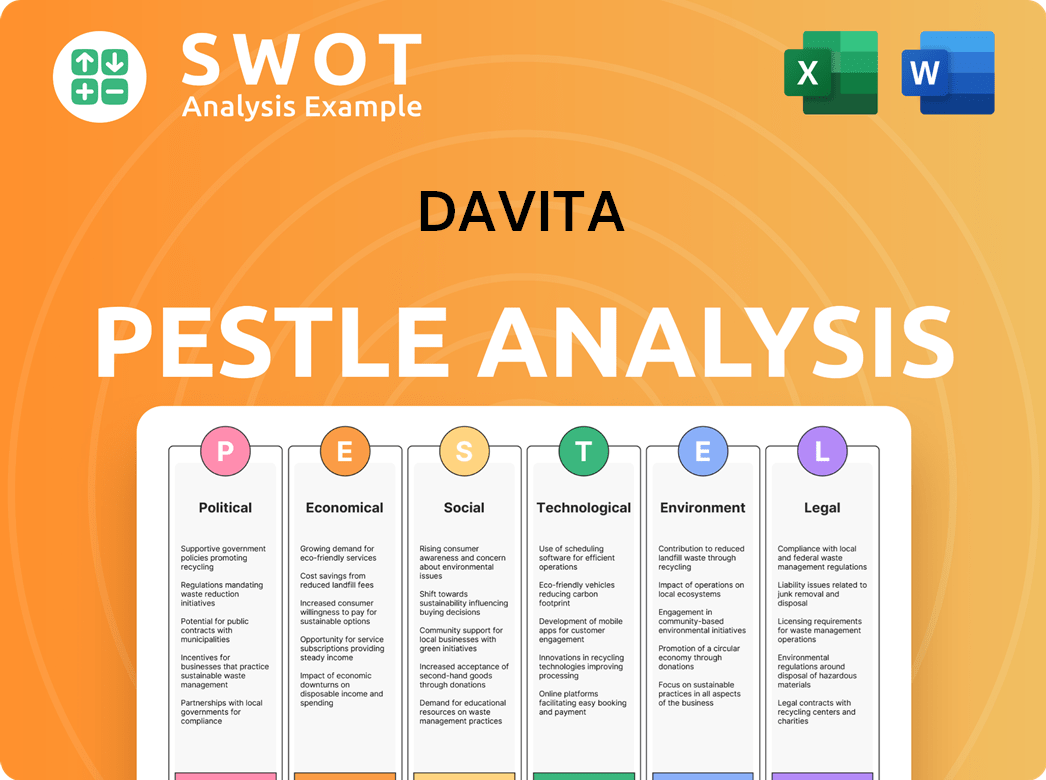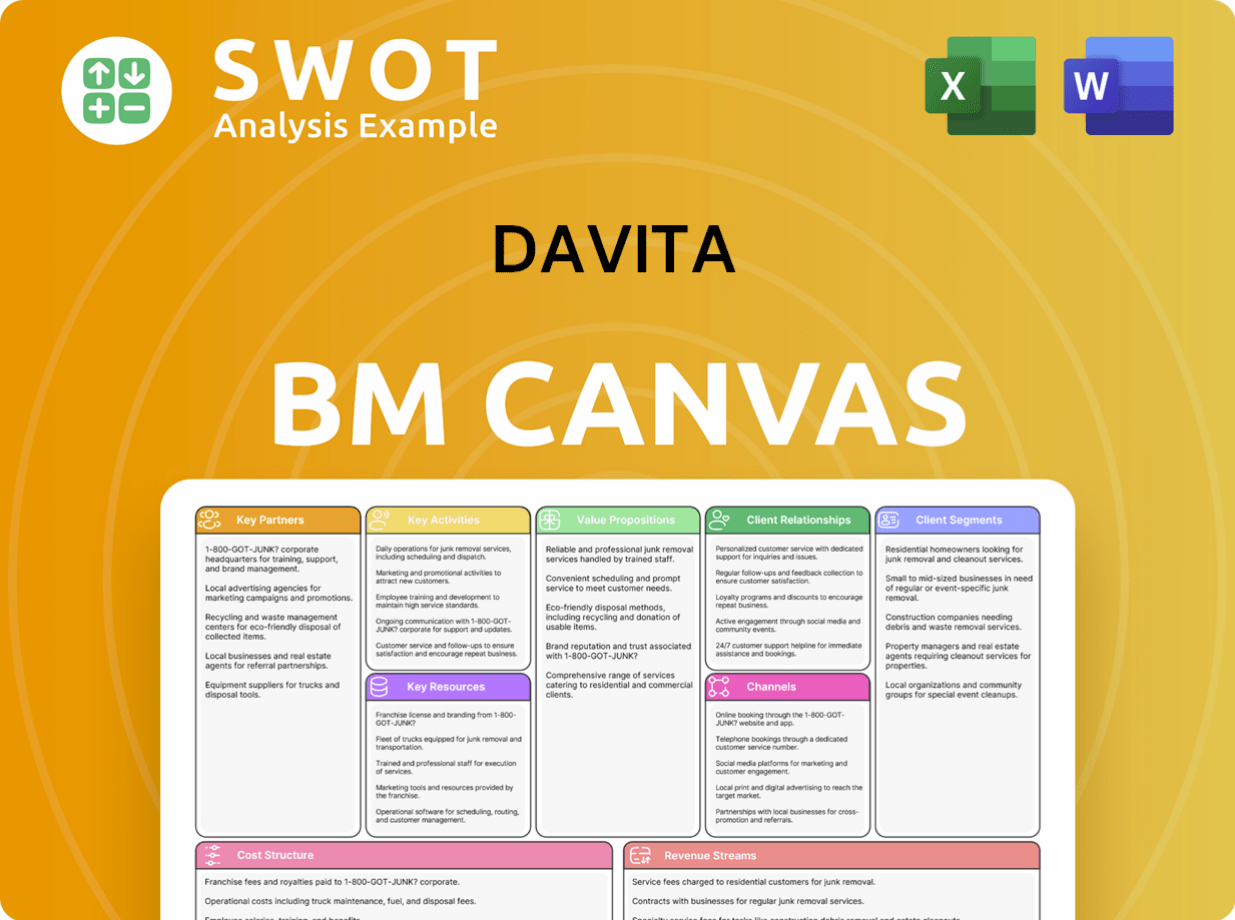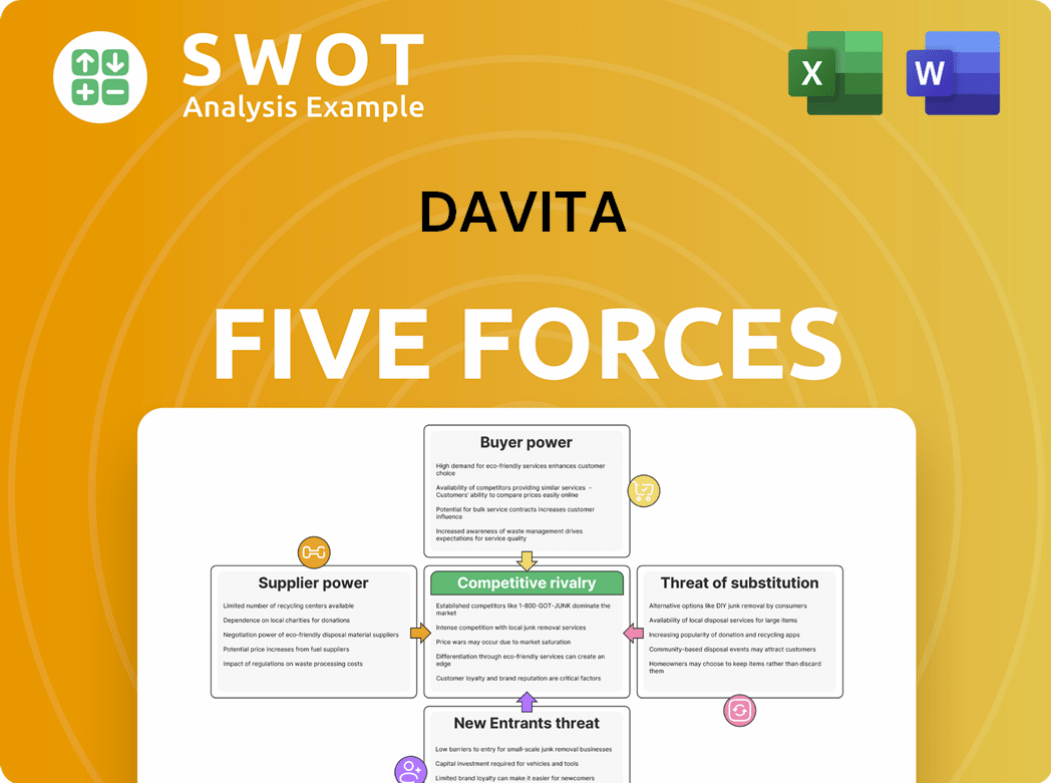DaVita Bundle
Who Does DaVita Serve? Unveiling the Patient Profile.
Understanding the DaVita SWOT Analysis is just the beginning; the true heart of DaVita's success lies in understanding its customers. DaVita Inc., a leader in kidney care, navigates a complex landscape shaped by evolving patient needs and demographic shifts. This exploration dives deep into the customer demographics and DaVita target market, providing critical insights for investors, healthcare professionals, and anyone interested in the future of healthcare.

DaVita's mission, deeply rooted in providing life-sustaining dialysis services, has driven its evolution from a service provider to a comprehensive healthcare partner. This shift reflects a strategic response to the changing needs of its patient profile, driven by factors like the aging population and the rising prevalence of chronic kidney disease. By examining the specifics of the DaVita company's customer base, including age, health conditions, and geographic locations, we gain a clearer understanding of its market position and future growth potential.
Who Are DaVita’s Main Customers?
Understanding the customer demographics and target market of the company is crucial for analyzing its business strategy. The primary customer segments of the company are individuals requiring specialized kidney care. This primarily includes those with chronic kidney failure and end-stage renal disease (ESRD), highlighting a specific patient profile.
The core focus of the company is on providing dialysis services. The patient population predominantly consists of older adults, particularly those over 65, who often have complex chronic conditions that necessitate ongoing medical intervention. This focus on kidney care defines its target market.
The company operates primarily as a business-to-consumer (B2C) provider, directly serving patients through its network of dialysis centers. However, it also has significant business-to-business (B2B) relationships. These relationships involve healthcare providers, including nephrologists and hospitals, as well as government payers and commercial insurers, shaping its customer segmentation analysis.
The patient profile mainly consists of older adults, often over 65, who have chronic kidney failure or ESRD. While detailed breakdowns by gender, education, or occupation aren't extensively detailed in public reports, the nature of ESRD indicates a patient population requiring consistent, long-term medical intervention. This demographic heavily influences the company's service offerings.
The company's target market is segmented into patients with ESRD, with a focus on providing dialysis services. Its business model includes B2C services to patients and B2B relationships with healthcare providers and payers. The company's revenue streams are significantly influenced by government programs and commercial insurers, as detailed in Revenue Streams & Business Model of DaVita.
In 2024, the U.S. Dialysis and Related Lab Services segment accounted for the majority of the company's revenue, totaling $11.4 billion, with Ancillary Services and Strategic Initiatives contributing $0.72 billion. Approximately 67% of the company's revenues in the U.S. came from Medicare and other government-based health insurance programs in 2023. Commercial payers, while accounting for 33% of revenues, generate nearly all of the company's profit due to higher reimbursement rates.
The company's 2025 guidance assumes flat U.S. treatment volume growth, signaling a shift from historical trends. It has expanded its target segments by offering integrated kidney care (IKC) and disease management services. This shift is prompted by a desire to improve clinical outcomes and adapt to changing healthcare models that emphasize coordinated and holistic patient management, impacting the company's market share dialysis patients.
The company's primary focus is on patients with ESRD, predominantly older adults, and its business model is a mix of B2C and B2B. The financial performance is significantly influenced by the payer mix, with government programs driving volume and commercial insurers driving profitability.
- Patient Profile: Primarily older adults with chronic kidney failure or ESRD.
- Revenue Sources: Government programs and commercial insurers.
- Strategic Shift: Expansion into integrated kidney care services.
- Financial Data: U.S. Dialysis revenue of $11.4 billion in 2024.
DaVita SWOT Analysis
- Complete SWOT Breakdown
- Fully Customizable
- Editable in Excel & Word
- Professional Formatting
- Investor-Ready Format

What Do DaVita’s Customers Want?
Understanding the customer needs and preferences is crucial for the success of the company. The core of the company's customer base consists of individuals requiring specialized kidney care, primarily those with chronic kidney disease (CKD) and end-stage renal disease (ESRD). These patients have very specific needs related to their health, treatment, and overall quality of life.
The primary motivation for these customers is access to life-sustaining dialysis treatments or kidney transplants. Their decision-making is significantly influenced by medical necessity, the recommendations of their physicians, and the availability of insurance coverage. They seek reliable and accessible treatment centers, skilled medical professionals, and a supportive care environment. The focus is on providing high-quality care that addresses the complex health needs of these patients.
The company addresses common pain points for kidney patients, including the need for specialized care and an integrated approach to managing their complex health needs. The company strives to offer tailored treatment plans, including in-center hemodialysis, peritoneal dialysis, and home hemodialysis. This approach acknowledges that 'dialysis is not a one-size-fits-all treatment', with patients having diverse medical needs and lifestyle preferences, as discussed in Brief History of DaVita.
The company's approach to patient care is shaped by a deep understanding of the needs and preferences of its customer base. This includes a focus on providing convenient, high-quality care, and personalized treatment plans. The company leverages data analytics to improve patient engagement and tailor its services to meet specific needs.
- Reliability and Accessibility: Patients need consistent and dependable access to dialysis treatments. The company's centers are strategically located to ensure accessibility.
- Skilled Medical Professionals: Patients prioritize the expertise and care provided by doctors, nurses, and other healthcare staff.
- Supportive Care Environment: Patients value a caring and empathetic atmosphere that supports their overall well-being. The company aims to create a supportive environment.
- Personalized Treatment Plans: Recognizing that each patient's needs are unique, the company offers various dialysis options, including in-center hemodialysis, peritoneal dialysis, and home hemodialysis. In 2022, over 15% of patients dialyzed from home.
- Patient Education and Empowerment: Through programs like Kidney Smart®, the company provides educational resources to help patients manage their kidney health and make informed decisions about their care.
- Value-Based Care: The company focuses on delivering high-quality care while managing costs, aligning with the increasing emphasis on value-based healthcare models.
DaVita PESTLE Analysis
- Covers All 6 PESTLE Categories
- No Research Needed – Save Hours of Work
- Built by Experts, Trusted by Consultants
- Instant Download, Ready to Use
- 100% Editable, Fully Customizable

Where does DaVita operate?
The geographical market presence of DaVita is substantial, with a strong focus on the United States and a growing international footprint. As of March 31, 2025, DaVita served approximately 282,000 patients globally through 3,173 outpatient dialysis centers. This includes 2,661 centers in the U.S., serving 200,800 patients, and 512 centers across 13 other countries, serving 49,400 patients.
In the U.S., DaVita holds a significant market share, approximately 35% of the dialysis market when measured by clinics, making it the largest provider of dialysis services in the country. Its operations span across 43 states and the District of Columbia. DaVita's expansion into new markets such as Ecuador and Chile, and increased presence in Colombia in 2024, reflects its commitment to global growth.
DaVita's strategy involves adapting to different healthcare systems, reimbursement structures, and cultural nuances in each country. DaVita's approach includes offering a comprehensive approach to healthcare, encompassing dialysis, primary care, and specialty services. The U.S. dialysis and related lab services segment accounts for the majority of its revenue, totaling $11.4 billion in 2024. To learn more about the company's ownership and financial aspects, you can explore Owners & Shareholders of DaVita.
DaVita's substantial market share in the U.S. dialysis market, approximately 35% by clinic count, highlights its strong position. This dominance is a key factor in understanding DaVita's overall business strategy and its ability to serve a large number of patients. The company's operations are spread across the majority of U.S. states.
DaVita's international expansion includes entering new markets like Ecuador and Chile, and expanding in Colombia during 2024. This growth strategy aims to diversify its revenue streams and serve a broader patient base. The company adapts its services to meet local healthcare needs.
The U.S. dialysis and related lab services segment generates the majority of DaVita's revenue. In 2024, this segment accounted for $11.4 billion, demonstrating the importance of the U.S. market to the company. This revenue distribution is key for assessing the company's financial health.
DaVita offers a comprehensive approach to healthcare, including dialysis, primary care, and specialty services. This integrated approach helps to meet the diverse needs of its patients. This strategy enhances patient care and can drive customer loyalty.
DaVita adapts to varying healthcare policies, reimbursement structures, and cultural nuances in different countries. This localization strategy is crucial for successful international operations. Adapting to local conditions enables DaVita to effectively serve patients worldwide.
As of March 31, 2025, DaVita served approximately 282,000 patients globally. The company's significant market share in the U.S. and its growing international presence highlight its ability to reach a large number of patients. This data underscores DaVita's impact in the dialysis market.
DaVita Business Model Canvas
- Complete 9-Block Business Model Canvas
- Effortlessly Communicate Your Business Strategy
- Investor-Ready BMC Format
- 100% Editable and Customizable
- Clear and Structured Layout

How Does DaVita Win & Keep Customers?
DaVita's approach to customer acquisition and retention hinges on a patient-centered care model designed to improve the lives of patients globally. This strategy involves a blend of targeted marketing, personalized care, and strategic partnerships, all focused on providing high-quality dialysis services and comprehensive kidney care.
For acquiring new patients, DaVita leverages data analytics to segment patient populations and tailor marketing messages. They also employ a personalized sales approach, understanding the specific needs of healthcare providers and patients. Partnerships, such as the one with the YMCA, help in identifying individuals with undiagnosed chronic kidney disease (CKD), thus expanding their reach within the target market.
Customer retention is a key focus, emphasizing patient engagement through educational materials, support groups, and personalized care plans. DaVita offers various treatment options, including in-center and home dialysis, and focuses on after-sales service through an integrated care model. Their commitment to quality outcomes and patient satisfaction is a central driver of retention. To learn more about the company’s expansion, check out the Growth Strategy of DaVita.
DaVita uses data-driven marketing to reach specific patient groups and healthcare providers. This includes customized messaging and segmentation to optimize campaign effectiveness. They focus on understanding the customer demographics and tailoring their approach accordingly.
Patient engagement is enhanced through educational resources, support groups, and personalized care plans. DaVita offers diverse treatment options, including home dialysis, to cater to individual preferences. The focus is on empowering patients in their healthcare journey.
DaVita has increased its focus on IKC, a value-based care segment aimed at reducing hospitalizations and improving patient outcomes. This strategy aligns with their goal to provide comprehensive kidney care. The IKC model helps in managing the patient profile effectively.
Investments in technology, such as connected cyclers for remote monitoring of home dialysis patients, enhance convenience and clinical outcomes. This contributes to better patient retention and improved dialysis services. These technological advances are crucial for the future.
DaVita utilizes CRM systems and data management for effective segmentation, allowing them to target existing customers more efficiently. This helps them understand different segments within their DaVita target market. This targeted approach is crucial for maximizing customer value.
DaVita's adjusted diluted net income per share for the year ended December 31, 2024, was $9.68. The 2025 guidance projects earnings between $10.20 and $11.30. These figures reflect the impact of their customer acquisition and retention strategies.
In 2024, DaVita repurchased 9.8 million shares for $1.389 billion. This signals confidence in their long-term strategy and customer value. This financial move can also be seen as a commitment to shareholder value.
Partnerships like the one with the YMCA help DaVita identify and reach potential patients with CKD. These partnerships are an essential part of their patient acquisition strategy. This helps expand their reach within the DaVita company.
DaVita's commitment to quality outcomes and patient satisfaction is a key driver for customer retention. This commitment involves continuous improvement in their services. This commitment is crucial for retaining patients.
The integrated care model at DaVita emphasizes after-sales service, involving collaboration among healthcare providers. This ensures comprehensive and coordinated care for patients. This approach helps improve patient satisfaction.
DaVita Porter's Five Forces Analysis
- Covers All 5 Competitive Forces in Detail
- Structured for Consultants, Students, and Founders
- 100% Editable in Microsoft Word & Excel
- Instant Digital Download – Use Immediately
- Compatible with Mac & PC – Fully Unlocked

Related Blogs
- What are Mission Vision & Core Values of DaVita Company?
- What is Competitive Landscape of DaVita Company?
- What is Growth Strategy and Future Prospects of DaVita Company?
- How Does DaVita Company Work?
- What is Sales and Marketing Strategy of DaVita Company?
- What is Brief History of DaVita Company?
- Who Owns DaVita Company?
Disclaimer
All information, articles, and product details provided on this website are for general informational and educational purposes only. We do not claim any ownership over, nor do we intend to infringe upon, any trademarks, copyrights, logos, brand names, or other intellectual property mentioned or depicted on this site. Such intellectual property remains the property of its respective owners, and any references here are made solely for identification or informational purposes, without implying any affiliation, endorsement, or partnership.
We make no representations or warranties, express or implied, regarding the accuracy, completeness, or suitability of any content or products presented. Nothing on this website should be construed as legal, tax, investment, financial, medical, or other professional advice. In addition, no part of this site—including articles or product references—constitutes a solicitation, recommendation, endorsement, advertisement, or offer to buy or sell any securities, franchises, or other financial instruments, particularly in jurisdictions where such activity would be unlawful.
All content is of a general nature and may not address the specific circumstances of any individual or entity. It is not a substitute for professional advice or services. Any actions you take based on the information provided here are strictly at your own risk. You accept full responsibility for any decisions or outcomes arising from your use of this website and agree to release us from any liability in connection with your use of, or reliance upon, the content or products found herein.